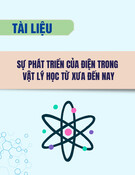
* Corresponding author.
E-mail addresses: abhiksur4@gmail.com (A. Sur)
© 2016 Growing Science Ltd. All rights reserved.
doi: 10.5267/j.esm.2016.6.002
Engineering Solid Mechanics 4 (2016) 187-200
Contents lists available at GrowingScience
Engineering Solid Mechanics
homepage: www.GrowingScience.com/esm
Three dimensional viscoelastic medium under thermal shock
Abhik Sur* and M. Kanoria
Department of Applied Mathematics, University of Calcutta, 92 A.P.C. Road, Kolkata-700009, West Bengal, India
A R T I C L EI N F O A B S T R A C T
Article history:
Received 6 March, 2016
Accepted 23 June 2016
Available online
23 June 2016
This article deals with the thermoelastic interaction in a three-dimensional homogeneous and
isotropic viscoelastic medium under the Dual-phase-lag model of generalized thermoelasticity.
The resulting non-dimensional coupled equations are applied to a specific problem of a half-
space whose surface is traction-free and is subjected to a time-dependent thermal shock. The
analytical expressions for the displacement components, stress, temperature and strain are
obtained in the physical domain by employing normal mode analysis. These expressions are
also calculated for a copper-like material and have been depicted graphically. Discussions have
been made to highlight the effect of viscosity on the studied field. The phenomenon of a finite
speed of propagation is observed for each field. Also, if the effect of viscosity is neglected, the
results agree with the existing literature.
© 2016 Growing Science Ltd. All rights reserved.
Keywords:
Generalized thermoelasticity
Dual-phase-lag thermoelastic
model
Kelvin-Voigt-model
Finite wave speed
Normal mode analysis
1. Introduction
Linear viscoelasticity has been an important area of research since the period of Maxwell,
Boltzman, Voigt and Kelvin. Valuable information regarding linear viscoelasticity theory may be
obtained in the books of Gross (1953), Alfery and Gurnee (1956), Ferry (1970), Bland (1960) and
Lakes (1998). Many researchers like Biot (1954, 1955), Gurtin and Sternberg (1962), Iiioushin and
Pobedria (1970), Tanner (1988) have contributed notably on thermoviscoelasticity. Freudenthal (1954)
have pointed out that most of the solids, when subjected to dynamic loading, exhibit viscous effects.
The Kelvin-Voigt model is one of the macroscopic mechanical model often used to describe the
viscoelastic behavior of a material. The model represents the delayed elastic response subjected to
stress when the deformation is time dependent but recoverable (Sur and kanoria, 2014a; Sur and
Kanoria, 2014b). The dynamic interaction of thermal and mechanical fields in solids has great practical
applications in modern aeronautics, astronautics, nuclear reactors and high-energy accelerators, for

188
example. Biot (1956) formulated the coupled thermoelasticity theory to eliminate the paradox inherent
in the classical uncoupled theory that elastic deformation has no effect on the temperature. The field
equations for both the theories are of a mixed parabolic-hyperbolic type, which predict infinite speeds
for thermoelastic signals, contrary to physical observations. Hetnarski and Ignaczak (1999) examined
five generalizations to the coupled theory of thermoelasticity. The first generalization is due to Lord
and Shulman (1967) who formulated the generalized thermoelasticity theory involving one relaxation
time. This theory is referred to as L-S theory or extended thermoelasticity theory (ETE) in which the
Maxwell-Cattaneo law replaces the Fourier law of heat conduction by introducing a single parameter
that acts as a relaxation time. The second generalization to the coupled theory of thermoelasticity is
due to Green and Lindsay (1972), called G-L theory or the temperature-rate dependent theory
(TRDTE), which involves two relaxation times. Problems concerning these generalized theories such
as ETE and TRDTE have been studied by Chandrasekharaiah (1986), Ignaczak (1989). Muller (1971)
proposed an entropy production inequality that led to restrictions on a class of constitutive equations.
A generalization of this inequality was developed by Green and Laws (1972). Green and Lindsay
obtained a modified version of the constitutive equations. These equations were independently obtained
by Suhubi (1975). For a review, works of Ignaczak (1989) may be mentioned where presentation of the
two theories and some important results are achieved in this field.
The third generalization to the coupled theory of thermoelasticity is known as low-temperature
thermoelasticity introduced by Hetnarski and Ignaczak (1996), called the H-I theory. This model is
characterized by a system of non-linear field equations. Low-temperature non-linear models of heat
conduction that predict wave-like thermal signals and which are supposed to hold at low temperatures
have also been proposed and studied in some works by Kosinski (1989) and Kosinski and Cimmmelli
(1997).
The fourth generalization to the coupled theory is concerned with the thermoelasticity theory
without energy dissipation (TEWOED) introduced by Green and Naghdi (1991, 1993), referred to as
G-N theory of type II in which the classical Fourier law is replaced by a heat flux rate-temperature
gradient relation. The heat transport equation does not involve a temperature-rate term and as such this
model admits undamped thermoelastic waves in thermoelastic material. In the context of linearized
version of this theory, theorem on uniqueness of solutions has been established by Chandrasekharaiah
(1996a, 1996b). The fourth generalization of the thermoelasticity theory developed by Green and
Naghdi also involves a heat conduction law, which includes the conventional law and one that involves
the thermal displacement gradient among the constitutive variables. This model is referred to as the GN
model III which involves dissipation of energy in general and admits damped thermoelastic waves.
Taheri et al. (2005) have employed Green-Naghdi theories of type II and type III to study the thermal
and mechanical waves in an annulus domain. Mallik and Kanoria (2007) have studied one dimensional
thermoelastic disturbance in an isotropic functionally graded medium in the context of generalized
thermoelasticity without energy dissipation. Problems concerning these theory have been studied by
many authors such as Bandopadhyay and Roychoudhuri (2005), Roychoudhuri and Bandopadhyay
(2005), Kar and Kanoria (2009b), Banik et al. (2007, 2009), Roychoudhuri and Dutta (2005), Mallik
and Kanoria (2008, 2009).
The fifth generalization to the thermoelasticity theory is known as the dual phase lag model
developed by Tzou (1995) and Chandrasekharaiah (1998). Tzou (1995) considered micro-structural
effects into the delayed response in time in the macroscopic formulation by taking into account that the
increase of the lattice temperature is delayed due to phonon-electron interactions on the macroscopic
level. A macroscopic lagging (or delayed) response between the temperature gradient and the heat flux
vector seems to be a possible outcome due to such progressive interactions. Tzou (1995) introduced
two-phase lags to both the heat flux vector and the temperature gradient and considered a constitutive
equation to describe the lagging behavior in the heat conduction in solids. According to this model,

A. Sur and M.Kanoria / Engineering Solid Mechanics 4 (2016)
189
classical Fourier’s law Tkq
= has been replaced by ),(=),( Tq tPTKtPq
, where the
temperature gradient T
at a point
P
of the material at time T
t
corresponds to the heat flux vector
q
at the same point at time q
t
. Here
K
is the thermal conductivity of the material. The delay time
T
is interpreted as that caused by the microstructural interactions and is called the phase-lag of the
temperature gradient. The other delay time q
is interpreted as the relaxation time due to the fast
transient effects of thermal inertia and is called the phase-lag of the heat flux. The case when
0== Tq
, correspond to classical Fourier’s law. If
=
q and 0=
T
, Tzou refers to the model as
single-phase-lag model. Roychoudhuri (2007) has studied one dimensional thermo-elastic wave
propagation in an elastic half-space in the context of dual-phase-lag model. Recently, several
researchers have attempted to solve their problems on the basis of the theory of dual-phase-lag model.
Quintanilla (2005, 2006, 2009) has solved several problems on the basis of this model. The exponential
stability (2002, 2003) and condition of the delay parameters in the dual-phase-lag theory under this
model have been studied by Quintanilla. Kumar, Prasad and Mukhopadhyay (2010) have studied the
propagation of finite thermal wave in the context of dual-phase-lag model. he problem o finite thermal
wave propagation in a half-space under variable thermal loading have been studied by Sur and Kanoria
(2014). Recently, Karmakar et. al (2016) have studied the thermoelastic wave propagation in an infinite
body having a spherical cavity under this theory. Also, a remarkable three-dimensional problem
emplying this theory have been solved by Kalkal and Deswal (2014).
The objective of the present contribution is to consider a three-dimensional Kelvin-Voigt thermo-
viscoelastic medium in which, the bounding plane is subjected to prescribed tempertaure and boundary
is free of tractions. The heat conduction equation has been formulated introducing dual-phase-lag heat
model of heat conduction. Introducing the normal mode analysis, the governing equations have been
expressed in cartesian coordiantes and are applied to a thermal shock problem in a viscoelastic body
which fills the half-space. The numerical estimates of the thermophysical quantities have been
computed for a copper-like material and have been depicted graphically to study the effect of viscosity
on the physical quantities. The results corresponding to the cases when the effect of viscosity is unseen,
agree with the results of the existing literature.
2. Basic Equations
The stress-strain-temperature relations are
*
=2 [ ] , , =1,2,3
ij ij ij
eij
** (1)
where ij
is the stress tensor, 0
is the reference temperature,
is the temperature field, the cubical
dilation, ii
e= and ij
e is the strain tensor given by
ijjiij uue ,,
2
1
=. (2)
Stress equation of motion in absence of body force is
1,2,3=,,=
,jiuijij
(3)
The heat equation for the dynamic coupled generalized thermoviscoelasticity based on the dual-phase-
lag thermoelasticity model is given by
ec
ttt
Kq
qT
0
2
2
2
2
2
1=1
å
, (4)

190
where 1,2,3)=( iui are the displacement component and
is the density,
c is the specific heat at
constant strain and the parameters
,
and
are defined as
000
=1 ,=1 ,=1
eee
ttt
***
, (5)
where, 0
is the viscoelastic relaxation time, e
, e
being Lame’s constant, t
)2(3=
; t
being the coefficient of linear thermal expansion. If 0=
T
, 0
=
q and neglecting 2
2
q
, Eq. (4) reduces
to the heat conduction equation corresponding to Lord-Shulman model; 0
being the relaxation time
for Lord-Shulman (LS) model.
3. Formulation of the Problem
We now consider an isotropic, homogeneous and thermoelastic medium with temperature
dependent mechanical properties in three-dimensional space which fills the region , where
is
defined by }<<,<<,0:),,({=
zyxzyx subjected to a thermal shock on the
bounding plane to the surface 0=x. The body is initially at rest and the surface 0=x is assumed to
be free of traction. Introducing the rectangular cartesian system ),,( zyx having an origin on the surface
0=x with the
x
axis vertical into the medium and the components of the displacement vector u
as
),,( wvu . The constitutive relations are
,1112= 000
t
e
tx
u
teeexx (6)
,1112= 000
t
e
ty
v
teeeyy (7)
,1112= 000
t
e
tz
w
teeezz (8)
,1= 0
x
v
y
u
t
exy
(9)
,1= 0
y
w
z
v
t
eyz
(10)
0
=1 .
zx e
uw
tzx
(11)
The equations of motion in absence of body forces are
,=1
1)(11)2(
0
22
0
2
2
2
2
0
2
2
0
u
xt
zx
w
yx
v
t
z
u
y
u
t
x
u
t
e
eeeee
(12)
,=1
1)(11)2(
0
22
0
2
2
2
2
0
2
2
0
v
yt
zy
w
yx
u
t
z
v
x
v
t
y
v
t
e
eeeee
(13)

A. Sur and M.Kanoria / Engineering Solid Mechanics 4 (2016)
191
222 22
00 0
222
0
( 2 )1 1 ( )1
1=.
ee e ee
e
www uv
tz t x y t xz yz
w
tz
(14)
The heat conduction equation for dual-phase-lag model is given by
2
222 2
00
222 2
1=1 1 .
2
q
Tqe
uvw
Kc
ttttxyz
xyz t
(15)
Eqs. (7-9) can be recast in the following form
,)(1= 2
2
2
2
2
0
xx
e
x
u
tx
u
eeee
(16)
,)(1= 2
2
2
2
2
0
yy
e
y
v
ty
v
eeee
(17)
22
2
022
=1 ( ) .
eeee
wwe
xtz zz
(18)
Introducing the following nondimensional variables
,=,=,=,=,=,=,= 2
0000000 tctwcwvcvucuzczycyxcx
,=,=',=,=,= 0
2
00
2
0
2
0
2
0
2
0
c
cc
cc ij
ij
e
TTqq
where
,=and
2
=2
2
0K
c
ce
and after removing primes, the above equations can be written in nondimensional form as follows
,)(11= 2
2
2
2
2
0
xx
e
x
u
tx
u
(19)
,)(11= 2
2
2
2
2
0
yy
e
y
v
ty
v
(20)
,)(11= 2
2
2
2
2
0
zz
e
z
w
tz
w
(21)
,1
2
1=1 00
2
2
2
2
e
t
t
tt
q
qT
(22)
where
.
2
=and
)2(
=0
2
0
ee
e
ee
e
c
In a similar manner, we can transform the constitutive relations in nondimensional forms. The
dimensionless expressions for the constitutive are obtained by adding Eqs. (19-21) as follows,




















![Bộ câu hỏi lý thuyết Vật lý đại cương 2 [chuẩn nhất/mới nhất]](https://cdn.tailieu.vn/images/document/thumbnail/2025/20251003/kimphuong1001/135x160/74511759476041.jpg)
![Bài giảng Vật lý đại cương Chương 4 Học viện Kỹ thuật mật mã [Chuẩn SEO]](https://cdn.tailieu.vn/images/document/thumbnail/2025/20250925/kimphuong1001/135x160/46461758790667.jpg)




